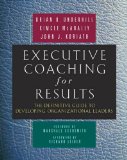In their book “Executive Coaching for Results”, Brian Underhill, Kimcee McAnally and John J. Koriath are blending their hands on experience in coaching hundreds of clients and their research results to emphasize the important role coaching has in many corporations today and how companies can use executive coaching to develop and retain their leaders.
A recent global survey of coaching clients by the International Coach Federation confirms the value of executive coaching. The survey showed that the average return-on-investment for companies investing in executive coaching was seven times the initial investment. More than a quarter reported a ROI of 10 to 49 times on their investment in executive coaching.
The need to coach leaders arises from talent management, development, attraction and retention policies. Traditional training teaches us how to do things but we usually don’t apply it when we are back at our jobs. Coaches help fill the gap between what to do and actually doing it. The target audience for executive coaching are leaders who are already holding C-level executive positions, or leaders who have a potential to grow and expand. Coaching gives the leader the rare opportunity to receive one-to-one attention unlike conventional training.
In most technology companies, C-level executives possess excellent technical or marketing skills. They are highly valued and highly paid, and they’re very good at what they do. The problem is what makes an individual performer successful does not make an effective leader or manager. Technology marketing and technology development leadership can benefit from executive coaches enabling them to combine their knowledge about technologies and marketing with their leadership skills.
The main reasons for hiring executive coaches are outlined by Brian Undershill and co-authors as:
- Leadership development. As Technology Multipliers, we believe all C level executives and potential leaders of technology companies will be able to align themselves better with the business goals, marketing and sales strategies, and technology choices made as they become multipliers in their leadership roles
- Leader transition. This may specially be very effective for leaders of sales, marketing and customer service teams. They can be coached on customer life time value while they become coaches for their own teams with the same principles. They can start to look at sales as long term commitments and long term relationships based on trust instead of trying to maximize short term sales
- High potential retention. The investment made in executives and leaders shows up as the company’s commitment to key talents. This becomes an important aspect of their intellectual asset development and protection policies. Receiving coaching definitely becomes a motivation for leaders to pursue their careers with the company who offers them this rare opportunity
- Performance issues – coaching is moving away from fixing performance problems nowadays
- Career coaching
- Life coaching
- Content specific coaching. Some leaders are individually coached on areas as public speaking, time management, and communication skills
Human Resources and Leadership Development teams are very heavily involved in planning and foreseeing the need for coaching in their companies. While leadership development looks at how to develop leaders and talent management looks at who and when; coaching combines these two with the company goals and strategies.
Coaching sometimes replaces the internal training, developmental job assignments. One of the trends in coaching is the move from general training to one to one development.
Once the screening is made thru HR and the good match is found for the leader, the next step is to have the necessary tools to conduct the coaching sessions. Many coaches and companies prefer different tools to accomplish the task at hand. It is also very crucial to lay down all the timelines, the completion criteria from the very beginning.
While coaching has a great outlook there are some challenges ahead. The ROI for coaching is very hard to measure. Although most companies measure the satisfaction of the leader rather than the actual results; this still remains to be an area that will need further clarification. Another topic is the standardization. Although it is very well known that one size does not fit all in coaching, we expect progress in this area too.
“Executive Coaching for Results” is not a how-to-coach book but rather a comprehensive guide on how to strategically use coaching to maximize talent development and link the impact of coaching to bottom-line results.

